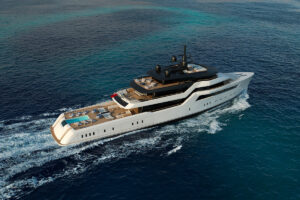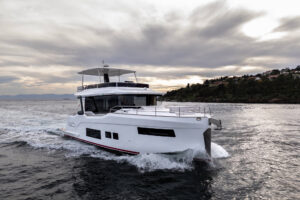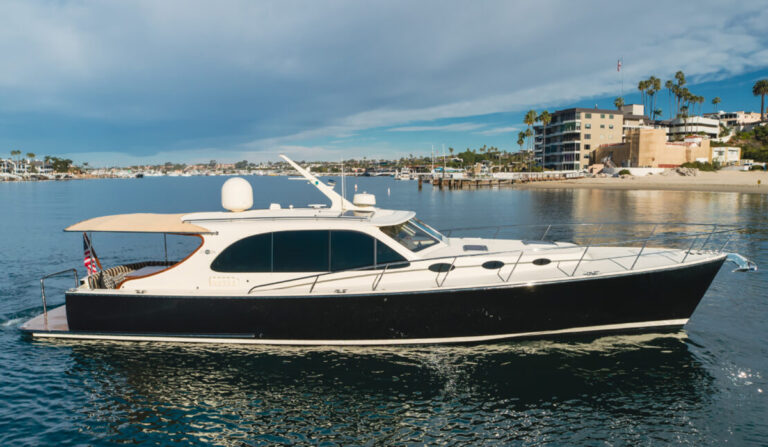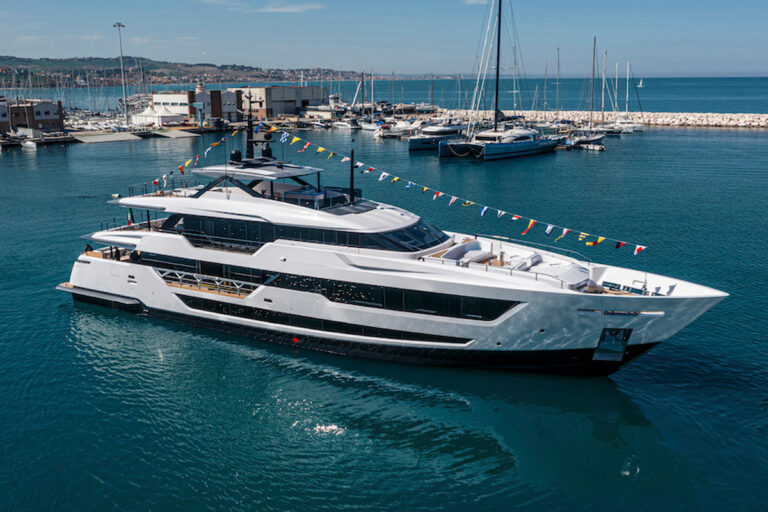Lady Ingeborg, a sleek 119-foot motor-yacht, is a work of modern art from a country better known for its Old Masters. Built alongside full-custom yachts at the builder’s yard in Oss, Holland, the Lady is the first of Heesen’s 3700 Series of semi-custom yachts. Six more 3700s are currently under construction for owners from several countries including the United States. Designed by Frank Laupman of Omega Architecten, the series allows wide latitude in decor and interior arrangement.
At the same time, buyers benefit from the cost savings possible when hull form, structural arrangements, and mechanical and auxiliary systems are standardized. Reduced cost should not be confused with a reduced level of quality, as I found Lady Ingeborg to be every bit as good as Heesen’s custom yachts. During a visit to the yard last winter, construction of the yacht was nearing completion, but joinery was not yet installed, allowing me to examine the all-aluminum structure, the wiring and the piping-all excellent. A return visit to the yacht this fall after her completion revealed an outstanding engineroom, indicative of the best in contemporary design and construction.
Clear and logical fuel and water manifolds are mounted on the forward bulkhead, and are built with ship-grade fittings. Underwater exhausts are neatly installed and do not intrude on the working space. The firefighting and bilge manifolds, served by separate pumps, are arranged so they can be cross-connected quickly to double capacity in an emergency. It is a feature that is nearly standard on commercial vessels but is too often omitted on yachts.
Lady Ingeborg is owned by a Dutch businessman who is also a designer. His influence on her interior is apparent in the multitude of hues and textures aboard. This makes the yacht an excellent first issue for the builder, showcasing what is possible within the generous bounds that is the Heesen semi-custom program. Heesen refers to the interior decor as “contemporary classic with art deco elements, but that doesn’t do it justice.
While much of the decor is a neutral palette of high-gloss, natural-finished wood and beige-toned soft goods, there are joinery highlights of tangerine and lilac, with burgundy ostrich-hide panels on some of the bulkheads. Especially striking are the conical furniture legs and other components that display an iridescent rainbow of colors transitioning from gold to mauve. In the brilliant Monaco sunlight streaming through Lady Ingeborg‘s seemingly endless array of windows, the yacht’s interior seemed to come alive.
As I walked through the yacht, the captain and his wife, two of the five crew normally carried, recounted their wonderful summer aboard Lady Ingeborg as she cruised the Med. They also confirmed Heesen’s report of the yacht maintaining her cruise speed of 27 knots in six- to eight-foot seas during her initial sea trials in the North Sea last spring. She is powered by two MTU 12V4000 engines driving five-blade Schaffran props, for a total of nearly 5,500 horsepower. Optional power for the series is a pair of MTU 16V4000 engines, with a projected top speed of 32 knots.
Early renderings of the 3700 Series show the yacht’s profile with a deep blue hull, and indeed some of the later deliveries will carry that attractive color scheme. Lady Ingeborg, however, sports a light creamy-gold hull with a white superstructure, with just enough difference in hues to highlight the sheer line. Unadorned by any painted sheer stripe or other colors, much like a naturally attractive woman sans makeup, Lady Ingeborg still presents beautiful lines, allowing one to appreciate what Laupman has done with light and shadow in her design.
This sleek profile wraps around an arrangement that is both traditional, with four guest staterooms below and an owner’s suite forward, and innovative, with features such as wide, comfortable side decks sloping from the open top deck, past the bridge, directly to the foredeck. Side decks extend from the aft deck to amidships on the main level, with the owner’s suite spanning the full beam forward.
Heesen’s experience as a builder of quality yachts is evident in both the overall construction and outfit, and in the details. Lady Ingeborg‘s high bow and ample flare will not let much water aboard, but what does come over the bulwarks will quickly find its way back to the sea through a series of large freeing ports both forward and aft. The handrails along the forward portion of the upper side deck are not overly high, but there are gates fitted amidships, near the pilothouse, that can be closed when conditions are unsafe. These gates, as well as the ones at the transom stairs, are of open construction to allow water to pass through while keeping guests on board.
Three of the four en suite guest staterooms belowdeck are fitted with queen berths. The two after cabins have more spacious showers and smaller hanging lockers, while the forward port cabin reverses the priorities. The fourth stateroom is designed for guest overload, with two twin berths and two Pullmans accommodating up to four guests. It is one of those arrangement choices that is up to the owner on a semi-custom yacht; others may opt for two twin cabins or a spacious VIP suite in this forward area.
As befits a yacht with this speed and power, the engineroom is large. A well-insulated watertight bulkhead at its forward end, as well as strategically placed heads in the aft staterooms, help keep heat, noise and vibration from reaching the guest accommodations. Abaft the engineroom is a spacious tender garage with a fold-out transom swim platform, overlooked by a rear-facing “rumbleseat.
The owner’s suite features the now-expected full beam head forward, but the arrangement is a bit different, and to my mind, more workable than many I’ve seen. A spacious, but not huge, circular shower lies on centerline, flanked by his-and-hers sinks. To port is a single toilet compartment, and to starboard, a whirlpool tub, again spacious but not huge. The galley abaft the owner’s suite includes private crew stairs to their cabin and mess area forward as well as to the raised pilothouse.
The circular layouts of the dining room and saloon are echoed in the patterns of the overheads, the forward one with spot lighting over the dining table and the after one with a mural surrounded by softer mood lighting. Large windows bring lots of light and view into both spaces, and curved glass doors and side panels open from the saloon to the aft deck. There’s lots of seating here, and stairs allow easy access down to the stern platform or up to the open top deck and flying bridge.
The top deck is sure to be a favorite of every guest. The flying bridge has full controls, but these fold down out of the way when not in use so as not to intrude on guest space. There are twin companion seats at the helm, with port and starboard bar areas abutting them. A teak dining table for 10 lies amidships and is partially shaded by the radar arch; additional shade is available via retractable awnings both forward and aft. The after end of the deck is outfitted with more seating and tables, as well as a raised whirlpool spa and extensive sun pads spanning the beam. Those wanting a bit more privacy or quiet can find it on the foredeck settee, easily reached via the sidedecks and a few steps.
Contact: Heesen Yachts, (011) 31 412 66554, info@heesenyachts.nl; www.heesenyachts.nl. In the U.S.: (954) 522-2300, tconboy@heesenusa.com; www.heesenusa.com.









